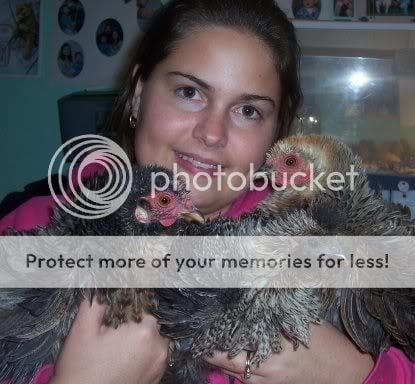- Oct 24, 2007
- 557
- 29
- 151
Hey everyone,
I have asked this before other places but never hear.
Ok so I have my Blue Silkie roo (blue skin, who may be a mix, according to someone who saw him said he looks big) and and Black Frizzle hen (yellow skin)
The two together I every so often get a brown chick with lighter and darker shades of brown striping and markings.
Once one grew up to be dark blue in color frizzle. The next two kept the brown, they are speckled in ways, and are frizzled. And then my next 2 hatches from them I got one of each, again frizzles. They two have kept some of the brown markings.
I have seen, black, blue, red, white frizzles but never this what I call "Chocolate Speckled" frizzle.
Anyone ever seen or heard of this? Any ideas of what I can breed them to to keep getting this color? I recently gave one to a friend we are not sure yet if it is a hen or roo, and I have another thats younger, so I had 4 and I would like to keep other colors so I decided to give her one so I had room for another somewhere else LOL
So I dont have a recent picture of my 2 older girls but you can see there older picture on my webpage. Here...
http://www.freewebs.com/terrascritters/xcritterportraitsx.htm
Comment My Guest Book!!
XOXO
I have asked this before other places but never hear.
Ok so I have my Blue Silkie roo (blue skin, who may be a mix, according to someone who saw him said he looks big) and and Black Frizzle hen (yellow skin)
The two together I every so often get a brown chick with lighter and darker shades of brown striping and markings.
Once one grew up to be dark blue in color frizzle. The next two kept the brown, they are speckled in ways, and are frizzled. And then my next 2 hatches from them I got one of each, again frizzles. They two have kept some of the brown markings.
I have seen, black, blue, red, white frizzles but never this what I call "Chocolate Speckled" frizzle.
Anyone ever seen or heard of this? Any ideas of what I can breed them to to keep getting this color? I recently gave one to a friend we are not sure yet if it is a hen or roo, and I have another thats younger, so I had 4 and I would like to keep other colors so I decided to give her one so I had room for another somewhere else LOL
So I dont have a recent picture of my 2 older girls but you can see there older picture on my webpage. Here...
http://www.freewebs.com/terrascritters/xcritterportraitsx.htm
Comment My Guest Book!!
XOXO










